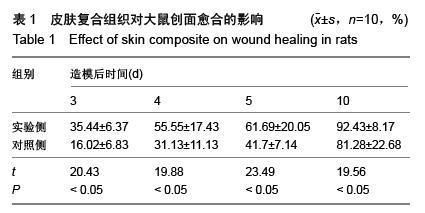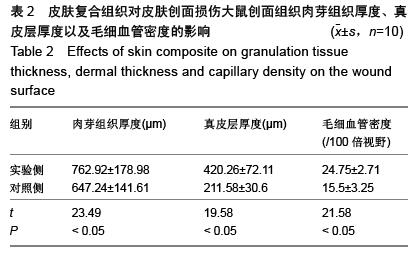| [1] Wang H, Zhang LC, Shi T, et al. Properties evaluation of collagen-hydroxyapatite-chondroitin sulfate-bone morphogenetic protein bone substitute material. Beijing Da Xue Xue Bao. 2011;43(5):730-734.
[2] Delawi D, Kruyt MC, Huipin Y, et al. Comparing autograft, allograft, and tricalcium phosphate ceramic in a goat instrumented posterolateral fusion model. Tissue Eng Part C Methods. 2013;19(11):821-828.
[3] Gilpin DA, Weidenbecher MS, Dennis JE. Scaffold-free tissue-engineered cartilage implants for laryngotracheal reconstruction. Laryngoscope. 2010;120(3):612-617.
[4] 邢捷,阙华发.八珍汤对大鼠慢性难愈性创面肉芽组织增殖细胞核抗原与细胞凋亡的影响[J].上海中医药大学学报,2011,25(2): 56-59.
[5] 樊慧杰,柴智,闫润红,等.补中益气汤对脾气虚症大鼠伤口肌肉组织Hyp,VEGF,α-SMA表达的影响[J].中国实验方剂学杂志,2013, 19(21):214-217.
[6] 徐杰男,阙华发,唐汉钧.补阳还五汤中不同黄芪剂量对促进大鼠难愈性创面愈合作用的观察[J].中国中西医结合外科杂志,2011, 17(2):177-180.
[7] Zhang Q, Fong CC, Yu WK, et al. Herbal formula Astragali Radix and Rehmanniae Radix exerted wound healing effect on human skin fibroblast cell line Hs27 via the activation of transformation growth factor (TGF-β) pathway and promoting extracellular matrix (ECM) deposition. Phytomedicine. 2012; 20(1):9-16.
[8] 张旭辉,董建勋,李健,等.回阳生肌方药对慢性皮肤溃疡大鼠创面愈合及炎症因子的影响[J].北京中医药大学学报,2013,36(3): 170-173.
[9] 赵春霖,王丽娟,董小鹏,等.生肌玉红膏对大鼠深Ⅱ度烧伤创面愈合过程中羟脯氨酸水平和胶原比例的影响[J].中成药,2013, 35(11): 2329-2332.
[10] 周倩,王燕,肖正华,等.黄芪多糖对糖尿病足溃疡成纤维细胞胶原合成的影响[J].解剖学研究,2011,33(2):135-137.
[11] 王振宜,肖秀丽,唐汉钧.复黄生肌愈创油膏对大鼠糖尿病创面中Ⅰ型和Ⅲ型胶原mRNA表达的动态影响[J].中国中西医结合外科杂志,2011,17(1):63-66.
[12] 赵春霖,王丽娟,董小鹏,等.生肌玉红膏对深Ⅱ度烧伤大鼠创面愈合过程中Ⅰ、Ⅲ型胶原表达变化的影响[J].中国中医药科技, 2013,20(5):467-468.
[13] 李巧芬,常柏,李云平,等.生肌象皮膏对糖尿病大鼠溃疡愈合中VCAM-1与ICAM-1的影响[J].天津中医药,2013,30(12):735- 738.
[14] 郭光丽,吴剑箫,刘梅珍,等.紫归解毒膏对大鼠背部粪便污染创面修复作用的实验研究[J].河北中医药学报,2013,28(3):4-7.
[15] Wu XB, Luo XQ, Gu SY, et al. The effects of Polygonum cuspidatum extract on wound healing in rats. J Ethnopharmacol. 2012;141(3):934-937.
[16] Lau TW, Lam FF, Lau KM, et al. Pharmacological investigation on the wound healing effects of Radix Rehmanniae in an animal model of diabetic foot ulcer. J Ethnopharmacol. 2009;123(1):155-162.
[17] 黄德彬,胡泽华,余昭芬,等.马桑提取物促进大鼠烧伤创面愈合的作用和机制[J].中国病理生理杂志,2013,29(1):138-144.
[18] 刘辉辉,肖丹,郑晓.龙血竭提取物促进创面愈合的实验研究[J].组织工程与重建外科杂志,2013,9(4):199-203.
[19] 江涛,刘兴太,张国权,等.新型生物创伤敷料的制备与研究[J].中国急救复苏与灾害医学杂志,2011,6(11):925-929.
[20] 赵亮,李敏.创面生物敷料及人工皮肤的研究进展[J].福建师范大学学报:自然科学版,2011,27(1):120-124.
[21] 李宗瑜,牟斌,李宜姝,等.负压封闭引流技术应用不当二例[J].中华烧伤杂志,2011,27(4):286.
[22] 周红菊,邓瑞文,饶忠,等.藻酸盐敷料治疗糖尿病足溃疡的临床观察和护理[J].护士进修杂志,2012,27(13):1219-1221.
[23] 邹新华,李春亭,冯自波,等.甲壳素蜂蜡膏促进大鼠创面愈合的实验研究[J].中华损伤与修复杂志:电子版,2012,7(2):52-54.
[24] 范小莉,肖蔓,吴英琼.银离子联合水凝胶敷料对术后感染伤口治疗效果的前瞻性研究[J].中国普外基础与临床杂志,2013,20(2): 209-211.
[25] Song J, Xu H, Lu Q, et al. Madecassoside suppresses migration of fibroblasts from keloids: involvement of p38 kinase and PI3K signaling pathways. Burns. 2012;38(5): 677-684.
[26] Wang X, Li Q, Hu X, et al. Fabrication and characterization of poly(L-lactide-co-glycolide) knitted mesh-reinforced collagen-chitosan hybrid scaffolds for dermal tissue engineering. J Mech Behav Biomed Mater. 2012;8:204-215.
[27] 刘洋,胡大海,董茂龙,等.负压封闭引流治疗小鼠创面铜绿假单胞菌感染的效果及机制[J].中华烧伤杂志,2011,28(4):255-259.
[28] Baldwin C, Potter M, Clayton E, et al. Topical negative pressure stimulates endothelial migration and proliferation: a suggested mechanism for improved integration of Integra. Ann Plast Surg. 2009;62(1):92-96.
[29] 曾丁,孙可,陶白江,等.改良式封闭负压疗法在难愈性创面中的应用体会[J].中华损伤与修复杂志:电子版,2011,6(6):957-959.
[30] Blume PA, Key JJ, Thakor P, et al. Retrospective evaluation of clinical outcomes in subjects with split-thickness skin graft: comparing V.A.C.® therapy and conventional therapy in foot and ankle reconstructive surgeries. Int Wound J. 2010;7(6): 480-487.
[31] Moiemen NS, Yarrow J, Kamel D, et al. Topical negative pressure therapy: does it accelerate neovascularisation within the dermal regeneration template, Integra? A prospective histological in vivo study. Burns. 2010;36(6):764-768.
[32] Borgquist O, Ingemansson R, Malmsjö M. Individualizing the use of negative pressure wound therapy for optimal wound healing: a focused review of the literature. Ostomy Wound Manage. 2011;57(4):44-54.
[33] Ortega J, Navarro V, Cassinello N, et al. Requirement and postoperative outcomes of abdominal panniculectomy alone or in combination with other procedures in a bariatric surgery unit. Am J Surg. 2010;200(2):235-240.
[34] 马杰,郭明锋,蔡卫林.负压治疗促进皮肤创面愈合的研究进展[J].中华损伤与修复杂志:电子版,2013,8(2):206-209. |
.jpg)




.jpg)